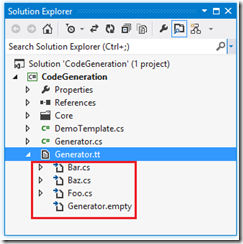对于企业开发来说,代码生成在某种意义上可以极大地提高开发效率和质量。在众多代码生成方案来说,T4是一个不错的选择,今天花了点时间写了一个简易版本的T4代码生成的“框架”,该框架仅仅是定义了一些基本的基类以及其他与VS集成相关功能的类型而已。[源代码从这里下载]
目录
一、T4模版的定义和代码文件的生成
二、TransformationContext与TransformationContextScope
三、Template
四、Generator
五、扩展方法RunCodeGenerator
一、T4模版的定义和代码文件的生成
我们先来看看最终的代码生成需要定义那些东西,以及T4模版应该如何定义。对于这个框架来说,代码结构的生成是通过继承自我们自定义基类Template的自定义类型实现的。作为演示,我们定义了如下一个DemoTemplate。从代码可以看出,DemoTemplate仅仅用于生成一个空类,类型名称在构造函数中指定。
1: public class DemoTemplate: Template
2: {
3: public string ClassName { get; private set; }
4: public DemoTemplate(string className)
5: {
6: this.ClassName = className;
7: }
8: public override string TransformText()
9: {
10: this.WriteLine("public class {0}",this.ClassName);
11: this.WriteLine("{");
12: this.WriteLine("}");
13: return this.GenerationEnvironment.ToString();
14: }
15: }
代码的生成最终通过执行相应的Generator来实现,为此我们定义了如下一个DemoGenerator。DemoGenerator最终会生成三个.cs文件,而每个文件的代码最终由上面定义的DemoTemplate来生成。如下代码片段所示,继承自Generator的DemoGenerator重写了CreateTemplates方法,返回一个字典对象。字典的Key代表生成的文件名,而Value则表示相应的Template对象。
1: public class DemoGenerator : Generator
2: {
3: protected override IDictionary<string, Template> CreateTemplates()
4: {
5: Dictionary<string, Template> templates = new Dictionary<string, Template>();
6: templates.Add("Foo.cs", new DemoTemplate("Foo"));
7: templates.Add("Bar.cs", new DemoTemplate("Bar"));
8: templates.Add("Baz.cs", new DemoTemplate("Baz"));
9: return templates;
10: }
11: }
最后我们在T4文件中以如下的方式执行DemoGenerator来生成我们需要的三个.cs文件。
1: <#@ template hostspecific="true" language="C#" #>
2: <#@ assembly name="$(TargetDir)Artech.CodeGeneration.dll" #>
3: <#@ import namespace="Artech.CodeGeneration" #>
4: <#@ output extension=".empty" #>
5: <#
6: this.RunCodeGenerator(this.Host, new DemoGenerator());
7: #>
三个.cs文件(Foo.cs、Bar.cs和Baz.cs)最终会以如下的方式生成出来。
二、TransformationContext与TransformationContextScope
接下来我们来简单看看Generator最终是如何利用Template生成相应的文本文件的,不过在这之前我们先来了解一下TransformationContext与TransformationContextScope这两个类型。顾名思义,TransformationContext用于存储T4文本转换的上下文信息,而TransformationContextScope用于限制TransformationContext的作用范围,这与Transaction/TransactionScope的关系一样。
TransformationContext定义如下,静态属性Current表示当前的TransformationContext,通过它可以得到当前的TextTransformation (即T4文件本身对应的那个TextTransformation 对象),当前的TextTemplatingEngineHost,以及针对T4文件的DTE和ProjectItem。
1: public class TransformContext
2: {
3: public static TransformContext Current { get; internal set; }
4: public TextTransformation Transformation{get; private set;}
5: public ITextTemplatingEngineHost Host {get; private set;}
6: public DTE Dte { get; private set; }
7: public ProjectItem TemplateProjectItem { get; private set; }
8:
9: internal TransformContext(TextTransformation transformation, ITextTemplatingEngineHost host)
10: {
11: this.Transformation = transformation;
12: this.Host = host;
13: this.Dte = (DTE)((IServiceProvider)host).GetService(typeof(DTE));
14: this.TemplateProjectItem = this.Dte.Solution.FindProjectItem(host.TemplateFile);
15: }
16:
17: public static void EnsureContextInitialized()
18: {
19: if (null == Current)
20: {
21: throw new TransformationException("TransformContext is not initialized.");
22: }
23: }
24: }
TransformationContext的构造函数是Internal的,所以不能在外部直接构建,我们通过具有如下定义的TransformationContextScope来创建它并将其作为当前的TransformationContext。TransformationContextScope实现了IDisposable接口,在实现的Dispose方法中当前的TransformationContext被设置为Null。
1: public class TransformContextScope: IDisposable
2: {
3: public TransformContextScope(TextTransformation transformation, ITextTemplatingEngineHost host)
4: {
5: TransformContext.Current = new TransformContext(transformation, host);
6: }
7:
8: public void Dispose()
9: {
10: TransformContext.Current = null;
11: }
12: }
三、Template
代码生成的逻辑实现在继承自具有如下定义的Template类型中,而它是TextTransformation的子类。Template的核心是Render和RenderToFile方法,前者指将生成的代码写入T4文件对应的生成文件中,后者则将内容写入某个指定的文件之中。Template生成的代码内容都是通过调用TransformText获取,在Render方法中直接通过当前TransformContext获取T4文件本身代表的TextTransformation对象,并调用其Wirte方法进行内容的写入。
而RenderToFile方法由于涉及到生成新的文件,逻辑就相对复杂一些。它先通过当前TransformContext得到TextTemplatingEngineHost并计算出T4所在的目录,并最终解析出生成文件最终的路径。文件的创建和内容的写入通过调用CreateFile方法实现,如果涉及到Source Control,还需要执行Check Out操作。新创建的文件最终通过代表T4文件的ProjectItem对象添加到Project之中。
1: public abstract class Template: TextTransformation
2: {
3: private bool initialized;
4: public override void Initialize()
5: {
6: base.Initialize();
7: initialized = true;
8: }
9: internal void EnsureInitialized()
10: {
11: if (!initialized)
12: {
13: this.Initialize();
14: }
15: }
16: public virtual void Render()
17: {
18: TransformContext.EnsureContextInitialized();
19: string contents = this.TransformText();
20: TransformContext.Current.Transformation.Write(contents);
21: }
22: public virtual void RenderToFile(string fileName)
23: {
24: TransformContext.EnsureContextInitialized();
25: string directory = Path.GetDirectoryName(TransformContext.Current.Host.TemplateFile);
26: fileName = Path.Combine(directory, fileName);
27: string contents = this.TransformText();
28: this.CreateFile(fileName, contents);
29: if (TransformContext.Current.TemplateProjectItem.ProjectItems.Cast<ProjectItem>().Any(item => item.get_FileNames(0) != fileName))
30: {
31: TransformContext.Current.TemplateProjectItem.ProjectItems.AddFromFile(fileName);
32: }
33: }
34: protected void CreateFile(string fileName, string contents)
35: {
36: if (File.Exists(fileName) && File.ReadAllText(fileName) == contents)
37: {
38: return;
39: }
40: SourceControl sourceControl = TransformContext.Current.Dte.SourceControl;
41: if (null != sourceControl && sourceControl.IsItemUnderSCC(fileName) && !sourceControl.IsItemCheckedOut(fileName))
42: {
43: sourceControl.CheckOutItem(fileName);
44: }
45: File.WriteAllText(fileName, contents);
46: }
47: }
四、Generator
T4文件中最终是通过执行Generator对象来生成代码的,如下是这个抽象类型的定义。它定义了两个虚方法,其中CreateTemplates方法一组基于独立文件的Template对象,返回字典的Key代表生成文件名称;CreateTemplate返回直接生成在当前T4文件对应生成文件的Template对象。代码生成通过调用Run方法来完成,而最终的逻辑定义在虚方法RunCore中。
在RunCore方法中,先便利通过CreateTemplates方法返回的Template对象并调用其RenderToFile进行独立文件的代码生成,然后调用CreateTemplate方法返回的Template对象的Render方法将代码生成于默认的代码文件中。最终执行RemoveUnusedFiles用于生成无用的文件。比如T4文件原来生成Foo.cs文件,现在修改T4文件内容使之生成Bar.cs文件,之前的文件应该在T4文件执行之后被删除。
1: public abstract class Generator
2: {
3: protected virtual IDictionary<string, Template> CreateTemplates()
4: {
5: return new Dictionary<string, Template>();
6: }
7: protected virtual Template CreateTemplate()
8: {
9: return null;
10: }
11: public void Run()
12: {
13: this.RunCore();
14: RemoveUnusedFiles();
15: }
16: protected virtual void RunCore()
17: {
18: foreach (var item in this.CreateTemplates())
19: {
20: item.Value.RenderToFile(item.Key);
21: }
22: Template template = this.CreateTemplate();
23: if (null != template)
24: {
25: template.EnsureInitialized();
26: template.Render();
27: }
28:
29: }
30: protected virtual void RemoveUnusedFiles()
31: {
32: List<string> codeFiles = new List<string>();
33: string directory = Path.GetDirectoryName(TransformContext.Current.Host.TemplateFile);
34: foreach (var item in this.CreateTemplates())
35: {
36: codeFiles.Add(Path.Combine(directory, item.Key));
37: }
38: var projectItems = TransformContext.Current.TemplateProjectItem.ProjectItems.Cast<ProjectItem>().ToArray();
39: foreach (ProjectItem projectItem in projectItems)
40: {
41: string fileName = projectItem.get_FileNames(0);
42: if (!codeFiles.Contains(fileName))
43: {
44: projectItem.Delete();
45: }
46: }
47: }
48: }
五、扩展方法RunCodeGenerator
在我们的实例演示中,T4文件中执行Generator是通过调用方法RunCodeGenerator来实现的,这是一个针对TextTransformation的扩展方法。如下面的代码片段所示,方法先根据指定的TextTransformation 和TextTemplatingEngineHost 创建当前TransformContext,对Generator 的Run方法的调用是在当前TransformContext中完成的。
1: public static class TextTransformationExtensions
2: {
3: public static void RunCodeGenerator(this TextTransformation transformation, ITextTemplatingEngineHost host, Generator generator)
4: {
5: using (TransformContextScope contextScope = new TransformContextScope(transformation, host))
6: {
7: generator.Run();
8: }
9: }
10: }
出处:http://artech.cnblogs.com/
本文版权归作者和博客园共有,欢迎转载,但未经作者同意必须保留此段声明,且在文章页面明显位置给出原文连接,否则保留追究法律责任的权利。
